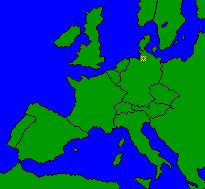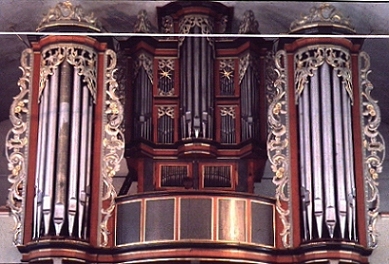

Osterholz-Scharmbeck |
IntroductionScharmbeck is a small town near Bremen, in North Germany. The organ was built by Erasmus Bielfeld and completed in 1734. Some of its pipes may be from an earlier organ by Arp Schnitger, completed in 1678. Outline of the organ's history:
Disposition
In its overall design, this is typical of small organs built for village churches by Schnitger and his followers in North Germany. There is no Rückpositiv, and the pedal was originally outside the case behind the Hauptwerk. The main case has the basic elements of north German cases, with the taller tower in the center, two-story flats, and a narrow base. The doors of the Brustwerk, which are closed in the photograph, are painted to show the general layout of the pipes that are visible when the doors are open. The manual keyboards, chests, and action are all original, but the pedal keyboard and chests were replaced during the 1971 restoration. With the exception of the 2' Cornet, the reeds are original, including most of the tongues. They are quite powerful, with an emphasis on the fundamental that is enhanced by leathered shallots in the Pedal Posaune - - also original. The Gemshorn is perhaps the stop that provides the biggest surprise to organists who have grown up in the United States, because it has none of the string-like quality most often found here. The scale is large, and although the pipes are quite tapered (moreso than is normal in the related stop, the Spitzflöte) the mouth width, cut-up and general voicing approach are what we normally expect to find in flutes.168 The resulting sound is quite large and clear, really that of a colorful open flute.
The manual keyboards, chests, and action are all original, but the pedal keyboard and chests were replaced during the 1971 restoration. With the exception of the 2' Cornet, the reeds are original, including most of the tongues. They are quite powerful, with an emphasis on the fundamental that is enhanced by leathered shallots in the Pedal Posaune - - also original. The Gemshorn is perhaps the stop that provides the biggest surprise to organists who have grown up in the United States, because it has none of the string-like quality most often found here. The scale is large, and although the pipes are quite tapered (moreso than is normal in the related stop, the Spitzflöte) the mouth width, cut-up and general voicing approach are what we normally expect to find in flutes.168 The resulting sound is quite large and clear, really that of a colorful open flute.
© 2000 AD James H. Cook | |||||||||||||||||||||||||||||||||||||||||||||||||||||||||||||||||||||||||||||||||||||||||||||||||||||||||||||||||||||||||||||||||||||||||||||||||||||||||||||||||||||||||||||||||||||||||||||||||||||||||||||||||||||||||||||||
|
|
 In its overall design, this is typical of small organs built for village churches by Schnitger and his followers in North Germany. There is no Rückpositiv, and the pedal was originally outside the case behind the Hauptwerk. The main case has the basic elements of north German cases, with the taller tower in the center, two-story flats, and a narrow base. The doors of the Brustwerk, which are closed in the photograph, are painted to show the general layout of the pipes that are visible when the doors are open.
In its overall design, this is typical of small organs built for village churches by Schnitger and his followers in North Germany. There is no Rückpositiv, and the pedal was originally outside the case behind the Hauptwerk. The main case has the basic elements of north German cases, with the taller tower in the center, two-story flats, and a narrow base. The doors of the Brustwerk, which are closed in the photograph, are painted to show the general layout of the pipes that are visible when the doors are open.